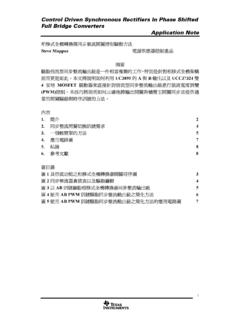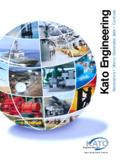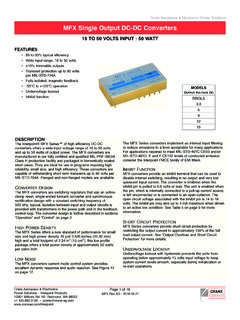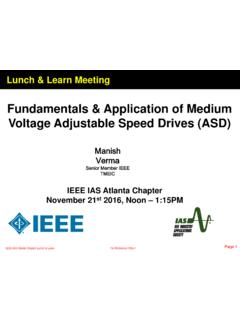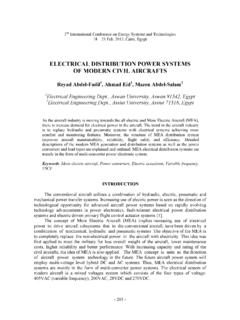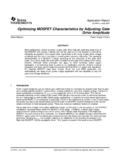Transcription of Basic Principles and Functions of Electrical Machines
1 Basic Principles and Functions of Electrical Machines Okoro, *, Agu, , and E. Chinkuni, 1 Department of Electrical Engineering, University of Nigeria, Nsukka, Enugu State, Nigeria * E-mail: 2 Polytechnic University of Namibia, Windhoek, Namibia E-mail: ABSTRACT Recent advances in power electronics and high-speed microprocessors have led to considerable attention in Electrical Machines with regard to their applications in industrial drives. This paper brings to the fore, various types of Electrical Machines , their operations, and applications, as well as the method of determining their parameters. Various ways of protecting electric Machines against overloads and mechanical faults are also highlighted.
2 It is anticipated that the work presented in this paper will be of immense benefit to practicing engineers especially in areas of machine design, maintenance, and protection. (Keywords: Electrical Machines , operation design, maintenance, protection, stator) INTRODUCTION The Direct Current ( ) machine , the synchronous machine , and the induction machine are the major electromechanical conversion devices in industry [1]. The merits of the squirrel cage induction machine are: lightness, simplicity, ruggedness, robustness, less initial cost, higher torque-inertia ratio, capability of much higher speeds, ease of maintenance, etc [2, 3].
3 The most important feature which declares it as a tough competitor to Machines in the drives field is that its cost per KVA is approximately one fifty of its counter-part and it possesses higher suitability in hostile environment. Unfortunately, induction Machines suffer from the drawback that, in contrast to Machines , their speed cannot be easily and effectively adjusted continuously over a wide range of operating conditions [4]. On the other hand, the synchronous machine has the merit of being operated under a wide range of power factors, both lagging and leading, and are much better suited for bulk power generation.
4 In the induction motor, alternating current is applied to the stator and alternating currents are induced in the rotor by transformer action. In the synchronous machine , direct current is supplied to the rotor and Alternating Current ( ) flows in the stator. On the other hand, a machine is a machine that is excited from sources only or that itself acts as a source of [5]. It is a common practice in industry to employ motors whenever they are inherently suitable or can be given appropriate characteristics by means of power electronics devices. Yet, the increasing complexity of industrial processes demands greater flexibility from Electrical Machines in terms of special characteristics and speed control.
5 It is in this field that the Machines , fed from the supply through rectifiers, are making their mark. In this paper, we shall discuss the various types of electric Machines , thereafter, we shall look at the Basic features and Principles of operation of electric Machines . Determination of machine parameters, Basic protections, maintenance, and electric machine applications are also discussed. CLASSIFICATION OF ELECTRIC Machines There are several methods of classifying electric Machines [6]: Electric power supply - Electric Machines are classified as and Machines as well as according to their stator and rotor constructions as shown in Figure 1.
6 National Electric Manufacturers Association (NEMA) Standards - NEMA standards are voluntary standards of the National Electric Manufacturers Association and represent general practice in industry. They define a product, process, or procedure with reference to nomenclature composition, construction, dimensions, tolerances, operating characteristics, performance, quality, rating, and testing. NEMA classifications of Electric Machines are summarized in Table 1. The Pacific Journal of Science and Technology 45 Volume 7.
7 Number 1. May 2006 (Spring) Figure 1: Classification of Electric Machines . Table 1: NEMA Classifications. Types Features A. Open: i. Drip-proof ii. Guarded iii. Externally ventilated B. Totally enclosed: i. Non-ventilated (TENV) ii. Fan-cooled (TEFC) iii. Water-cooled Cooled by circulating water Operate with dripping liquids up to 150 from vertical Guarded by limited size openings (less than inch) Ventilated with separate motor driven blower, can have other types of protection Not equipped for external cooling Cooled by external integral fan The Pacific Journal of Science and Technology 46 Volume 7.
8 Number 1. May 2006 (Spring) Basic FEATURES OF ELECTRIC Machines The Basic structural features of a machine are: Stator - The stator carries the field winding. The stator together with the rotor constitutes the magnetic circuit or core of the machine . It is a hollow cylinder. Rotor - It carries the armature winding. The armature is the load carrying member. The rotor is cylindrical in shape. Armature Winding - This winding rotates in the magnetic field set up at the stationary winding. It is the load carrying member mounted on the rotor. An armature winding is a continuous winding; that is, it has no beginning or end.
9 It is composed of a number of coils in series as is shown in Figure 2. Depending on the manner in which the coil ends are connected to the commutator bars, armature windings can be grouped into two: lap windings and wave windings. Wave winding gives greater voltage and smaller current ratings while the lap winding supplies greater current and smaller voltage ratings [7]. Figure 2: An Armature Coil. Field Winding - This is an exciting system which may be an Electrical winding or a permanent magnet and which is located on the stator. Commutator - The coils on the armature are terminated and interconnected through the commutator which comprised of a number of bars or commutator segments which are insulated from each other.
10 The commutator rotates with the rotor and serves to rectify the induced voltage and the current in the armature both of which are Brushes - These are conducting carbon graphite spring loaded to ride on the commutator and act as interface between the external circuit and the armature winding. Poles - The field winding is placed in poles, the number of which is determined by the voltage and current ratings of the machine . Slot/Teeth - For mechanical support, protection from abrasion, and further Electrical insulation, non-conducting slot liners are often wedged between the coils and the slot walls.





